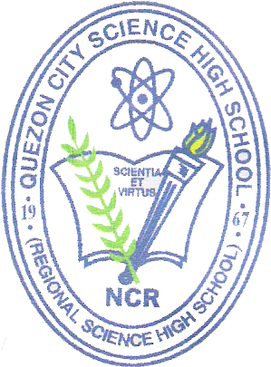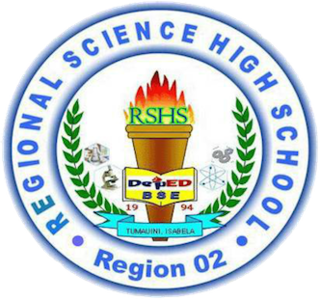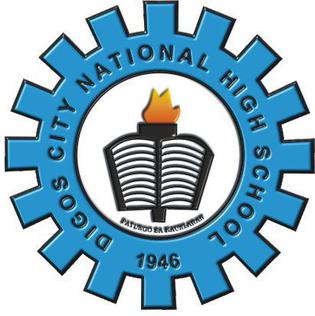
Quezon City Science High School is the Regional Science High School for the National Capital Region. It is the premier science high school of Quezon City, and is regarded as one of the prestigious sciences triumvirate of the Republic of the Philippines along with the Philippine Science High School and Manila Science High School. It is located at Golden Acres Road, Corner Misamis Street, Bago-Bantay, Quezon City, Philippines. Founded in September 17, 1967, it was appointed as the Regional Science High School for the National Capital Region since 1998.
Regional Science High School Union (RSHS-Union) is a specialized system of public secondary schools in the Philippines, established during the academic year 1994-1995. It is operated and supervised by the Department of Education, with a curriculum heavily focusing on math and science. It remains within the ambit of the Department of Education, unlike the specialized science high school system of national scope, the Philippine Science High School.
Education in the Philippines is compulsory at the basic education level, composed of kindergarten, elementary school, junior high school, and senior high school. The educational system is managed by three government agencies by level of education: the Department of Education (DepEd) for basic education; the Commission on Higher Education (CHED) for higher education; and the Technical Education and Skills Development Authority (TESDA) for technical and vocational education. Public education is funded by the national government.
The Rizal National Science High School, commonly known as RNSHS, RiSci, or Rizal Science is a public science high school on Jose P. Rizal St., Batingan, Binangonan, Rizal, Philippines. It was founded in 1998.

The Regional Science High School for Region VI (formerly Aklan Development High School / Science Development High School of Aklan / Science Development National High School is a public secondary science school supervised by the Department of Education. It is located in Old Buswang, Kalibo, Aklan, Philippines.
The Science, Technology, Engineering and Mathematics Education Program is a science and mathematics-oriented curriculum devised for high schools in the Philippines. The STEM program is offered by specialized high schools, whether public or private, supervised by the Department of Education. Currently, there are 110 high schools offering the STEM program, the majority being public. It was piloted in 1994 by the Department of Science & Technology (DOST).

Regional Science High School is located at Camp Samal, Arcon, Tumauini, Isabela, in the Cagayan Valley Region. Its present principal is Dr. Nevin Gabriel. Past principals include Mr. Inocencio T. Balag, Dr. Fabio M. Macalling, Jr., Mr. Peter Batarao, and Ms. Nelia Z. Angoluan. Regional Science High School has a curriculum that specializes in science and mathematics.
San Jose School of La Trinidad Inc. is a private Catholic school located in the municipality of La Trinidad, Benguet, Philippines.

The Divino Amore Academy (DAA), formerly known as Divine Love High School, is a private sectarian school in Mohon, Talisay City, Cebu, Philippines. The school derives its mission from the apostolate of the Augustinian Sisters of Divine Love (ASDL). Their charism is to dedicate themselves to the education of children and youth and to the teaching of catechism.
St. Michael Academy, a private, sectarian, non-stock Catholic secondary school in Catarman, Northern Samar, Philippines. It is the first and only Catholic learning institution established in the city, owned and operated by the Congregation of the Dominican Sisters of St. Catherine of Siena - Philippines; thus, the only Dominican educational institution found in the Samar - Leyte region operating since 1946.
Caraga Regional Science High School is a public school in San Juan, Surigao City, Philippines. It is the leading school in the Division of Surigao City with high MPS during the annual National Achievement Tests (NAT), and has been consistent in making its name in Division, Regional, National and International level contests.

The University of Baguio, formerly Baguio Technical and Commercial Institute, is a private, Filipino, multidisciplinary, autonomous university in Baguio, Philippines. It was founded by Fernando Gonzaga Bautista and Rosa Castillo Bautista on August 8, 1948, with 80 students. The student population in 2018 was about 18,000 in its tertiary level.
Taguig Science High School (TSHS), abbreviated as TagSci or TagSat, is a public science high school in Taguig, Philippines. It is one of three science high schools of the City of Taguig, and it is managed by the Schools Divisions Office of Taguig City and Pateros (SDO-TAPAT). TSHS traces its roots from the Special Science class of Signal Village National High School.

Digos City National High School (DiCNHS), formerly known as Davao del Sur National High School, is situated at Rizal Avenue, Zone II, Digos, is one of the biggest schools in Davao Region, under the jurisdiction of the DepEd Division of Digos. Digos City National High School is also once the second largest secondary school in the country in terms of student population, second only to Rizal National High School in Pasig. Founded in August 1946 with the name of Digos Junior High school.

The Camarines Sur National High School, also called CamHi, is the oldest national high school in Camarines Sur and one of the biggest public secondary schools in the Bicol Region, Philippines, having a student population of 11,899 in the school year 2021–2022. It was established in 1902.

St. Paul College of Makati, also referred to as SPCM or SPC Makati, is a private, co-educational, Catholic educational institution located at D.M. Rivera Street, Poblacion, Makati, Metro Manila, Philippines, and administered by the Sisters of Saint Paul of Chartres (SPC).
Polangui General Comprehensive High School (PGCHS) is the flagship secondary school of the municipality of Polangui in the province of Albay. It has an average population of 4,000 students. PGCHS has seven present curricula. It is located along the Buhi-Polangui Road at Purok Earth, Centro Occidental, Polangui, Albay; having a total service area of 48,708 square meters. It is 39.1 kilometers away from the Department of Education (DepEd) Albay Division Office.
Davao Oriental Regional Science High School (School I.D. 304328) is a public science high school supervised by the Department of Education. The school was established on May 28, 2009, through the R.A. No. 9630 as the Regional Science High School for Region XI: Davao Region. It is located in Mati City, Davao Oriental, Philippines. The school is colloquially known as "DORSHS", "RegSci", or simply "RS".
Information Communications Technology is usually included in the Home Economics and Livelihood Education program in grade school and taught through the Technology and Home Economics program in high school. The recent status of ICT education in the Philippines, along with other Southeast Asian countries, was surveyed by the Southeast Asian Ministers of Education Organization (SEAMEO) in 2011. Using the UNESCO model of ICT Development in Education, the countries were ranked as Emerging, Applying, Infusing or Transforming. The Philippines were ranked at the Infusing stage of integrating ICT in education, indicating that the country has integrated ICT into existing teaching, learning and administrative practices and policies. This includes components such as a national vision of ICT in education, national ICT plans and policies, complementary national ICT and education policies, professional development for teachers and school leaders, community or partnership and teaching and learning pedagogies. A 2012 study reported that public high schools in Metro Manila had a computer to student ratio of 1:63. While 88 percent of schools have internet connections, half of the students claimed not to be using it.
Crossing Bayabas National High School is a public secondary school in Toril, Davao City, Davao Del Sur, Philippines, conceived on November 22, 1997, following the approval of the Republic Act No. 8388 authored by the late Congressman Elias B. Lopez.








